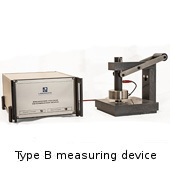Definitions of electrostatic FIBCs
Concerning the aspects of the avoidance of electrostatic-ignition hazards, up to now four types of FIBCs (A, B, C and D) are in use according to their ability of charge dissipation and/or limiting the energy of possible discharges. These four types of FIBCs are explained below:
| Type A: | FIBCs made from non-conductive materials without any measures against electrostatic charging. As no electrical conductive material is interwoven in the fabric grounding and charge dissipation is hardly possible. Explosive atmospheres of gases as well as explosive atmospheres of dusts can be ignited. Therefore, a Type A FIBC must not be used to handle combustible dusts. If such a FIBC containing inert material has to be used in hazardous areas, this may only happen in zones 2 or 22. |
| Type B: | FIBCs made from non-conductive materials having a breakdown voltage not exceeding 6 kV. This reliably prevents the ignition of explosive dust atmospheres while explosive gas atmospheres can still be ignited. Like Type A, the Type B has no interwoven conductive materials. Thus, a Type B FIBC can be used where combustible dusts are present, but it shall not be used in hazardous areas, zones 1 or 0.Type B FIBC are permitted in Dust Zone 21-22 with MIE > 3 mJ (MIE = Minimum Ignition Energy). |
| Type C: | FIBCs normally made of non-conductive fabric with interwoven conductive threads
The inner or outer surfaces of the FIBC may have a thin coating. In this case the breakdown voltage to the conductive threads must not exceed 6 kV to avoid propagating brush discharges. Thus, Type C FIBCs can be used in an environment with combustible dusts and/or explosive gases. There is no risk using these FIBCs in hazardous areas zones 1, 2, 21, 22, providing they are properly grounded. |
| Type D: | FIBCs made from non conductive materials containing an arrangement of conductive fibres which have no electrical contact to each other. These FIBCs are not conductive but enable a certain charge dissipation into the environment via corona-effect. Grounding of a Type D FIBC is not possible. Sometimes these bags are treated with an "antistatic coating" lowering the surface resistance of the fabric. Because of the charge dissipation into the surrounding area via corona discharge, the Type D FIBC can easily charge insulated conductive objects or persons standing nearby. Those objects or persons can, when contacting ground or grounded objects, cause electrostatic spark discharges capable of igniting explosive mixtures of gases or vapors. Thus, Type D FIBCs may be used with combustible dusts, but only in hazardous areas zones 2 and 22 as it is allowed for FIBCs of Type B with the prerequisite that the breakdown voltage is less than 6 kV to be verified by testing. The application of a Type D FIBC in a hazardous area zone 1 requires further measures decreasing its effective charge to a non-hazardous degree. Some manufacturers claim that FIBCs of Type D may be used in explosive gas atmospheres if the charge accumulation will not exceed specified values which are stated on the bag. But these instructions seem not to be very helpful to the user. For safe use of Type D-FIBCs - meeting the requirements stated above – in a hazardous area, zone 1, it must be pointed out, that all conductive objects and persons in the vicinity of the FIBC must be grounded during the filling and emptying process. This instruction for grounding is to be set forth in words on each bag. |
For further information click Electric FIBCs.
(014)






